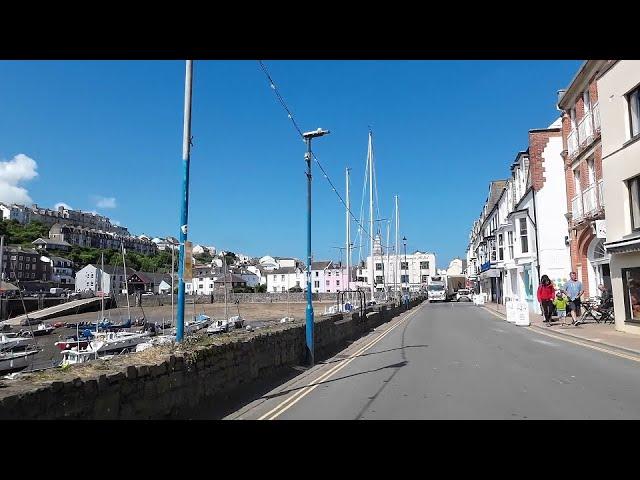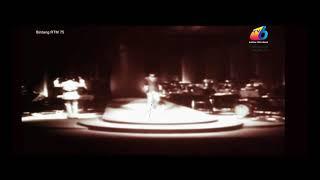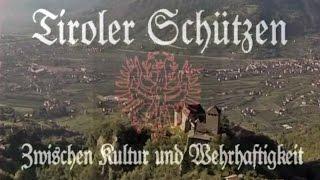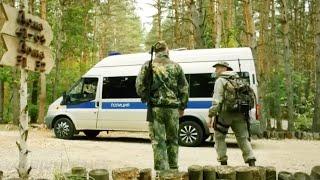
A Drive Through Ilfracombe Seafront And Harbour From Mullacott Cross North Devon/
Ilfracombe is a seaside resort and civil parish on the North Devon coast, England, with a small harbour surrounded by cliffs.
The parish stretches along the coast from the 'Coastguard Cottages' in Hele Bay toward the east and 4 miles (6 km) along the Torrs to Lee Bay toward the west. The resort is hilly and the highest point within the parish boundary is 'Hore Down Gate', 2 miles (3 km) inland and 860 feet (270 m) above sea level.
The landmark of Hillsborough Hill dominates the harbour and the site of an Iron Age fortified settlement. In the built environment, the architectural-award-winning Landmark Theatre has a distinctive double-conical design. The 13th century parish church, Holy Trinity, and the St Nicholas's Chapel (a lighthouse) on Lantern Hill, have been joined by Damien Hirst's statue of Verity as points of interest.
Ilfracombe has been settled since the Iron Age, when the Dumnonii (the Roman name for the inhabitants of the South-West) established a hill fort on the dominant hill, Hillsborough (formerly Hele's Barrow). The origin of the town's name has two possible sources. The first is that it is a derivative of the Anglo-Saxon Alfreinscoma - by which name it was noted in the Liber Exoniensis of 1086. The translation of this name (from Walter William Skeat of the department of Anglo Saxon at Cambridge University) means the "Valley of the sons of Alfred". The second origin is that the name Ilfracombe was derived from Norse illf (bad), Anglo-Saxon yfel (evil ford) and Anglo-Saxon cumb (valley) perhaps from a Celtic source (compare Welsh cwm), thus 'The valley with the bad ford'.
The manor house at Chambercombe in east Ilfracombe was recorded in the 1086 Domesday Book as being built by a Norman knight Champernon (from Chambernon in France) who landed with William of Normandy. It is also said to be haunted.
Ilfracombe comprised two distinct communities; a farming community around the parish church called Holy Trinity, parts of which date from the 12th century, and a fishing community around the natural harbour formed between Capstone, Compass and Lantern Torrs. It is recorded that the lands by the church were part of the estate owned by Champernowne family, while those by the harbour belonged to the Bouchier family: Earls of Bath.
Because of the natural layout of the harbour, Ilfracombe became a significant safe port (registered port of refuge) on the Bristol Channel. It also had trade routes between Kinsale and Tenby, which made the port stronger. In 1208 it was listed as having provided King John with ships and men to invade Ireland; in 1247 it supplied a ship to the fleet that was sent to conquer the Western Isles of Scotland; 6 ships, with 79 men were sent to support the siege of Calais. Ilfracombe was the last disembarkation point for two large forces sent to subdue the Irish. The building which sits on Lantern Hill by the harbour, known as St Nicholas's Chapel (built 1361) is reputed to be the oldest working lighthouse in the UK; a light/beacon has been there for over 650 years.
The parish stretches along the coast from the 'Coastguard Cottages' in Hele Bay toward the east and 4 miles (6 km) along the Torrs to Lee Bay toward the west. The resort is hilly and the highest point within the parish boundary is 'Hore Down Gate', 2 miles (3 km) inland and 860 feet (270 m) above sea level.
The landmark of Hillsborough Hill dominates the harbour and the site of an Iron Age fortified settlement. In the built environment, the architectural-award-winning Landmark Theatre has a distinctive double-conical design. The 13th century parish church, Holy Trinity, and the St Nicholas's Chapel (a lighthouse) on Lantern Hill, have been joined by Damien Hirst's statue of Verity as points of interest.
Ilfracombe has been settled since the Iron Age, when the Dumnonii (the Roman name for the inhabitants of the South-West) established a hill fort on the dominant hill, Hillsborough (formerly Hele's Barrow). The origin of the town's name has two possible sources. The first is that it is a derivative of the Anglo-Saxon Alfreinscoma - by which name it was noted in the Liber Exoniensis of 1086. The translation of this name (from Walter William Skeat of the department of Anglo Saxon at Cambridge University) means the "Valley of the sons of Alfred". The second origin is that the name Ilfracombe was derived from Norse illf (bad), Anglo-Saxon yfel (evil ford) and Anglo-Saxon cumb (valley) perhaps from a Celtic source (compare Welsh cwm), thus 'The valley with the bad ford'.
The manor house at Chambercombe in east Ilfracombe was recorded in the 1086 Domesday Book as being built by a Norman knight Champernon (from Chambernon in France) who landed with William of Normandy. It is also said to be haunted.
Ilfracombe comprised two distinct communities; a farming community around the parish church called Holy Trinity, parts of which date from the 12th century, and a fishing community around the natural harbour formed between Capstone, Compass and Lantern Torrs. It is recorded that the lands by the church were part of the estate owned by Champernowne family, while those by the harbour belonged to the Bouchier family: Earls of Bath.
Because of the natural layout of the harbour, Ilfracombe became a significant safe port (registered port of refuge) on the Bristol Channel. It also had trade routes between Kinsale and Tenby, which made the port stronger. In 1208 it was listed as having provided King John with ships and men to invade Ireland; in 1247 it supplied a ship to the fleet that was sent to conquer the Western Isles of Scotland; 6 ships, with 79 men were sent to support the siege of Calais. Ilfracombe was the last disembarkation point for two large forces sent to subdue the Irish. The building which sits on Lantern Hill by the harbour, known as St Nicholas's Chapel (built 1361) is reputed to be the oldest working lighthouse in the UK; a light/beacon has been there for over 650 years.
Комментарии:
Jasmin Hussein - Angin Malam Bintang RTM 1974
IMRAN IBRAHIM
드디어 저렴한 신규분양이? 버퀴틀람 파크 디스트릭트 #밴쿠버부동산
밴쿠버 서수지 부동산
...E continuavano a fregarsi il milione di dollari | Italiano | Lee Van Cleef
Grjngo - Film Western
Tiroler Schützen zwischen Kultur und Wehrhaftigkeit
Südtiroler Schützenbund
MINN_ Weekend plan
BGM NO.1
땅콩집 내부가 궁금하지 않으세요? 실내영상 공개.
건축가이현욱 주택의 모든것
Zakopane, Kasprowy Wierch | Hiking in Tatra Mountains in Poland
Where To Next, Dad?
聚焦2 0》白雁 彥寬老師Part2
白雁時尚氣功 BaiYinQigong


























